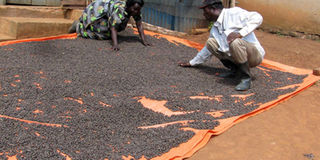Research shows farmers lose Shs16b every year in poor post-harvest handling

Farmers in Masaka spreading out coffee beans to dry. There are several stages after harvesting where most losses are registered.
What you need to know:
Despite the assumption that Ugandan farmers can expect high yields, the figures show a different story.
As Uganda marked World Food Day, October 16, facts and figures from a grassroots research paint a gloomy picture of the country’s food security situation. High on the list of causative factors is poor post-harvest handling, where there are massive losses to farmers, cumulatively leading to billions of shillings in key food-producing regions.
The study carried out by Uganda Cooperative Alliance (UCA) and Uganda National Farmers’ Federation (UNFFE) found that the largest grain-producing districts—Mubende and Masindi—are the hardest hit registering more than Shs16b in post-harvest losses every year.
Allan Wayira, the lead researcher, presented the report, “Improving Food Security Governance In East Africa: Addressing the challenges of Post-Harvest Losses and Inadequate Storage” at a stakeholder meeting in Kampala. He revealed that 97 per cent of farmers interviewed said they suffered losses during handling of their produce.
Biggest factor
“Most farmers incur losses during harvest (64 per cent) followed by storage (12 per cent) and drying (10 per cent). In Mubende, the average weight loss as a result of poor post-harvest handling is 30,000 metric tonnes of maize alone, worth over Shs13b while in Masindi, farmers lost grain worth Shs12.5b,” he said while explaining that post-harvest losses refers to decrease in edible food mass at harvest, post-harvest and processing stages.
“There are mainly five segments under the post-harvest chain where food losses occur; harvest, drying, threshing/shelling, grading/cleaning, farm storage, transportation, market storage,” Wayira added. “Post-harvest losses have a negative impact on food security for poor people, on food quality and safety, and on economic development.”
The higher incidence of losses at harvest is mainly attributed to the weather arising from rain that leads to damp conditions resulting in mould growth and the associated risk of aflatoxin contamination.
Other factors
Transportation is another factor in post-harvest losses. Spillage of grains during transportation was reported at 43 per cent and leakage (of grains from bags) stands at 31 per cent – mostly caused by poor roads and poor packaging materials. “About 50 per cent of farmers use their own houses for storage which also acts as a home for livestock subjecting the foodstuffs to post-harvest losses,” the report points out.
For about 32 per cent of farmers who use granaries, the challenges were insect-infestation, theft and rodents.
“The challenge associated with lack of appropriate storage facilities is selling produce immediately after harvest at low prices reported by 58 per cent of the farmers. With maize consumption at 15kg per capita per year, for example, maize lost in Masindi can feed up to 711,800 people in a year which is twice the population of Masindi district,” the study states.
Recommendation
With only a one per cent reduction in post-harvest loss in maize for Masindi, it is possible to get annual benefits of 617 tonnes or about Shs300m a year, Wayira said, stressing that these benefits would not only accrue to farmers but also other actors along the value chain.
Some of the proposed recommendations to curtail the serious losses, the report suggests, is the Uganda Food and Nutrition Policy (UFNP).
“UFNP provides that food and nutrition issues should be incorporated in the national, district, sub-county and sectoral development plans and aims to promote the formulation and/or review of appropriate policies, laws and standards for food security and nutrition.”
There is a draft Uganda Food and Nutrition Bill (2009) that provides a legal basis for implementing the UFNP.
The implementation of these strategic documents to promote food security and nutrition remains weak; 88 per cent of farmers store to await better price and sell to the market while only eight per cent store for food security.
About the story
The research was undertaken under The Farmers Voice Programme (FVP) for Kenya, Uganda and Tanzania and co-funded by the European Union (EU) and the Dutch agricultural agency, Agriterra.
This is under a new regional initiative, aimed at improving food security governance in East Africa. With a Belgian development organisation, Trias providing technical backstopping, the FVP focuses on participatory generation of food security-related policy issues, more specifically to empower smallholder farmers to demand better policies on post-harvest losses and strategic food reserves.




